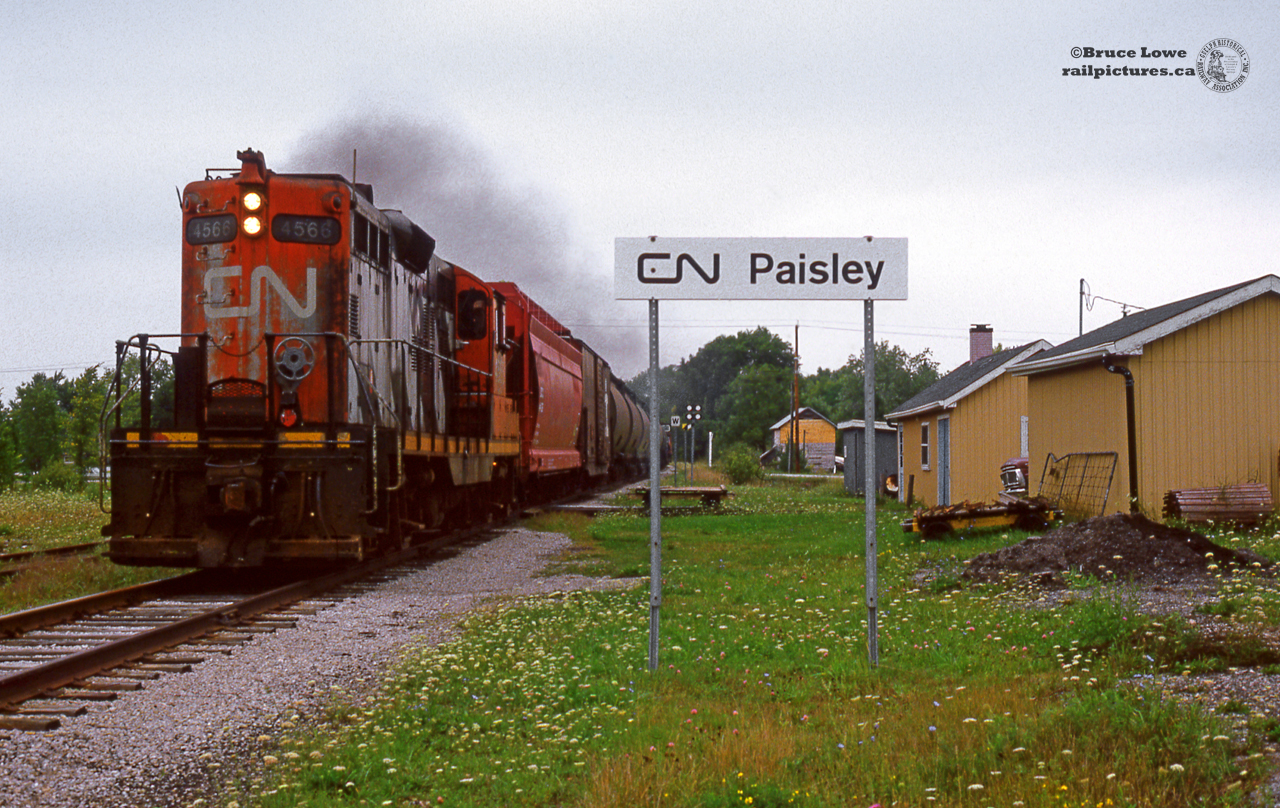|
Caption: The hogger on extra 4566 opens the throttle to get his train up to track speed after clearing the Teeswater River bridge at Paisley on the Southampton sub. Easy load for the geep with about 9 cars and the van, including a 12-axle depressed centre flatcar returning empty from Bruce Nuclear just ahead of the van.
While originally planned in 1856, the Southampton sub would not be completed until December, 1872. During the railway boom of the 19th century, the Canada North-West Railway (C.N.W.Ry.) was incorporated in May, 1856 to build a line from Toronto to Southampton. The line was surveyed by Sanford Fleming (who also surveyed the majority of both the Intercolonial Railway and Canadian Pacific Railway), but no work was completed due to lack of funds and the charter expired in 1861. In 1864 another attempt was made, now under the name of the Wellington, Grey & Bruce Railway with the intent of building from the Great Western Railway at Guelph (today CN Guelph Junction) north west to Southampton. Construction of the Provincial gauge line began in June, 1867 from Fergus, working west to Elora and north west to Alma. 1869 saw the Great Western Railway take over the physical operations of the W.G.& B. Ry. continuing construction south to Guelph in 1870 and north towards Palmerston. The G.W.R. sought an amendment to the original charter in 1870 to change the line from the Provincial gauge of 5ft - 6in to standard gauge, and to allow future lease of the line to the G.W.R. This was granted and construction continued under the new gauge and lease.
1871 saw the line open for service to Palmerston and Harriston while crews worked northward. Paisley was ready for service by June, 1872 and finally Southampton in December of that year. Starting in December, 1871, crews were working south west from Palmerston on a branch line to Kincardine via Listowel; eventually part of the CNR Newton Sub, and the Kincardine Sub. This portion would be ready for service in November, 1873, but would see no trains until December, 1874 due to costs owing to the contractor. Though there were further plans for expansion to Owen Sound and Durham, the lack of funds kept the line from pressing on, and the fact that other companies (Toronto, Grey & Bruce Rwy.) were building that way. Great Western Railway would take over operation of the trains in 1873, which soon after was merged with the Grand Trunk in 1882. Official amalgamation of the W.G.& B. into G.T.R. would take place in 1893, eliminating the Wellington, Grey & Bruce name entirely. 1923 saw the bankruptcy of the Grand Trunk and the creation of Canadian National Railways, who would operate the lines in the 1980's and early '90's. Passenger service ended November 1, 1970, one year after Paisley's station closed on October 24, 1969. Passengers would purchase their tickets onboard the Dayliner for that final year. 1970 saw the beginning of slightly increased freight service on the line with saw the construction of the 11.4 mile Douglas Point spur from Port Elgin south to the Heavy Water Plant at the Bruce nuclear Generating Station. The spur was used for unit trains of bunker C oil from Montreal (briefly) and later Sarnia allowing the plant to create steam for the early CANDU reactors. The requirement of these trains of 60 cars or so led to the Fergus, Owen Sound (Palmerston - Harriston), Newton, and Southampton subs receiving numerous upgrades in 1969 to rail and ties for the heavier trains. After about a decade the market for the CANDU reactors never took off and a generator was able to provide the reactors with enough heavy water, leading to the heavy water plant being shut down in 1984. With the lifeblood of the line gone, CNR applied to abandon the Southampton sub from Harriston to Douglas Point in 1988 (Port Elgin to Southampton had been abandoned in 1983.) The request was granted, and the line was removed during 1989.
CN GP9 4566 was built by GMD in 1957 and rebuilt to CN 7049 in 1991. The unit would be off the CN roster in 2009.
|



This is absolutely amazing.
Just awesome.